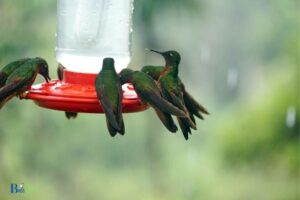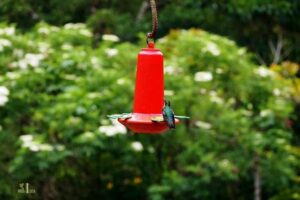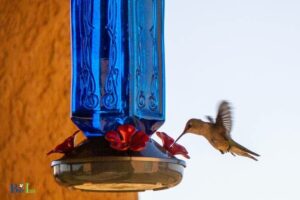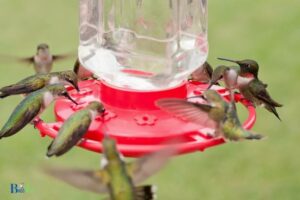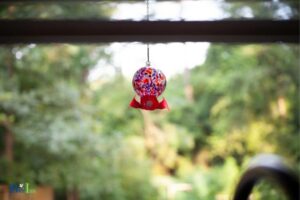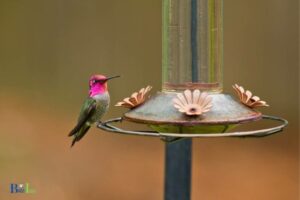What to Do With Hummingbird Feeder While on Vacation?
When going on vacation, it’s essential to ensure the hummingbirds visiting your garden continue to receive food & specific steps before leaving to guarantee the feeder continues to provide nourishment for the birds.
Hummingbirds are tiny creatures with a rapid metabolism that requires constant feeding. As a result, they rely heavily on the food sources available to them, such as hummingbird feeders.
If you’re going away, it’s crucial to make arrangements to ensure your feeder remains in working order and continues to provide sustenance to the hummingbirds in your absence.
Alternatively, setting up multiple feeders in your garden can provide additional food sources and reduce the chances of them running out while you’re gone.
Opt for a larger capacity feeder to store more nectar, delaying the need for a refill. Before departing, clean the feeder thoroughly to minimize the chances of mold or bacteria growth, ensuring the nectar remains safe and fresh for the birds.
6 Tasks & Solution for Hummingbird Feeder While on Vacation:
| Task | Solution |
| Stop the feeder from attracting birds | Empty the hummingbird feeder before leaving on vacation |
| Maintenance | Clean the feeder thoroughly to prevent mold or bacteria growth |
| Storage | Store the emptied and cleaned feeder in a cool, dry place out of direct sunlight |
| Refresh upon return | Refill with fresh nectar and check for any damage before hanging the feeder back up |
| Alternative care | Ask a neighbor or friend to maintain and refill the feeder while you are away |
| Automatic feeder | Consider investing in an automatic hummingbird feeder with a timer to release fresh nectar daily |
Key Takeaway
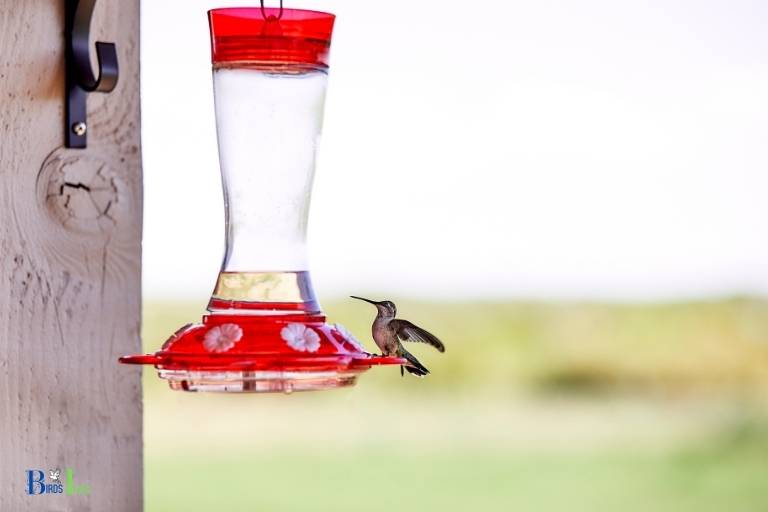
Four Facts About: Hummingbird Feeder While on Vacation
Exploring The Different Options Available
Leaving for a vacation is exciting, but what do you do with your hummingbird feeder? Leaving it behind without proper care can cause mold and mildew to form, possibly harming the birds that visit.
Luckily, there are several options to ensure a safe and healthy environment while you’re away.
Removing The Feeder
One option is to remove the feeder entirely. This method can work well if you have a short trip planned or have someone who can check on it regularly.
Removing the feeder eliminates the possibility of any harm to the birds, and it’s an easy solution that can be done in a matter of minutes.
Emptying The Feeder
Another option is to empty the feeder entirely. Hummingbird food is perishable and, if left unattended, can spoil quickly, leading to a possibly unhealthy environment for the hummingbirds.
This option is quick and straightforward and can help maintain a clean and safe feeder for the birds.
If you choose to empty the feeder, remember:
- Dispose of the old sugar-water mixture.
- Wash the feeder with soap and water.
- Rinse it thoroughly with hot water.
- Allow it to dry in a sunny spot.
Partially Emptying The Feeder
If your trip is longer, partially emptying the feeder might be a better option.
This method conserves the sugar-water mixture, so you don’t need to make as much when you return, yet still ensures adequate sustenance for any birds that visit while you’re away.
Partial emptying of the feeder means:
- Discarding half of the solution and preserving the other half.
- Covering the feeder with a breathable material like paper towels or a plastic bag with holes to protect it from insects.
- Removing the feeder’s base, wash it and allow it to dry.
Leaving The Feeder Full
Finally, suppose you’re on an extended vacation and you have someone trustworthy to look after your hummingbird feeder.
In that case, you can leave it full since there will be someone to monitor it. Leaving the feeder full means the hummingbirds can feed freely, ensuring their health and well-being.
Remember to instruct the caretaker to:
- Keep the feeder clean.
- Refill it every week to avoid the sugar-water mixture from spoiling.
- Replace the feeding solution entirely every 2-3 days during heatwaves.
Different circumstances can determine what to do with your hummingbird feeder when traveling.
Each method has its pros and cons, but the most important thing is to ensure proper care for the hummingbirds.
Whether you remove, empty, or leave it full, proper maintenance of the feeder ensures that the hummingbirds return to a safe and healthy environment.
Factors To Consider Before Deciding
When going on vacation, one of the questions on the mind of many bird lovers is what to do with their hummingbird feeders.
While some bird enthusiasts prefer to leave their feeders behind, others like to take them along. Whatever the case may be, certain factors need to be considered before making a decision.
Here are some essential things to keep in mind:
The Type Of Food In The Feeder
The first thing to consider before leaving your hummingbird feeder behind is the type of food you are using.
If you are using a homemade solution, you may need to replace it after a certain number of days to prevent it from going bad.
Alternatively, if you are using a store-bought solution, it may last longer. Regardless of the type of food you are using, it’s best to leave the feeder empty if you are going on a long vacation.
This way, you can prevent the possibility of harmful bacteria growing in the feeder.
The Weather Forecast
Another essential factor to consider before leaving your hummingbird feeder is the weather forecast.
If you are expecting rain or wind, it’s best to take the feeder down. Doing so will prevent it from falling and causing damage.
If you leave the feeder outside during harsh weather conditions, it can also damage the feeder and the nectar inside.
Moreover, birds may avoid the feeder if it’s too wet or windy outside.
The Location Of The Feeder
Before leaving for vacation, take a look at where the feeder is located. If it’s in a busy area, it may attract certain types of insects that could pose a problem while you’re away.
Additionally, if the feeder is hanging from a small tree branch or other unstable surface, there’s a possibility that it could fall and break.
It’s best to hang the feeder in a shady area with a sturdy hook that can support its weight.
The Length Of Your Vacation
Finally, the length of your vacation is an essential factor to consider before deciding what to do with your hummingbird feeder.
If you’re going on a short trip that lasts only a few days, it’s best to leave the feeder behind.
On the other hand, if you’re going on a long vacation, it’s best to take the feeder with you. Leaving the feeder outside for a long time could cause the nectar to go bad, which can harm the birds that drink from it.
Moreover, birds may become dependent on the feeder for food, leading to starvation if you’re away for too long.
Deciding what to do with your hummingbird feeder while on vacation requires careful consideration of several factors.
Take into account the type of food in the feeder, the weather forecast, the location of the feeder, and the duration of your vacation.
By doing so, you can ensure that the birds remain safe and healthy while you’re away.
Cleaning And Refilling Before Leaving
When you plan to go on a vacation, leaving behind your hummingbird feeder can be a bit tricky. You don’t want the birds to go hungry, but at the same time, you don’t want the nectar inside to spoil or become contaminated.
We’ll discuss what to do with a hummingbird feeder while on vacation, with a focus on cleaning and refilling before leaving.
Tips For Thorough Cleaning
Before you leave your home, it’s crucial to clean your hummingbird feeder thoroughly. This cleaning process will remove any mold, bacteria, and other contaminants that may have built up inside the feeder since the last time you cleaned it.
Here are some tips for thoroughly cleaning your hummingbird feeder:
- Dismantle the feeder: First, remove all parts of the feeder, including the bottle, lid, and base of the feeder.
- Soak in a mixture of hot water and vinegar: Fill a bowl with hot water and add white vinegar to it, making a 1:1 ratio. Place all the parts of the feeder in the bowl and let them soak for about an hour.
- Scrub with a bottle brush: Once the feeder parts have soaked for an hour, use a bottle brush to scrub the inside and outside of the bottle.
- Rinse with hot water: Rinse all the parts with hot water to ensure all the vinegar is removed.
- Let it dry: Leave all the parts to dry completely before refilling.
Importance Of Clean Feeder
Hummingbirds are attracted to nectar that is fresh, clean, and free from contaminants. If the nectar becomes spoiled, moldy, or contaminated, it can harm the hummingbirds, making them sick or even causing death.
This is why it’s essential to keep your hummingbird feeder clean and refill it with fresh nectar.
Refilling The Feeder With Fresh Nectar
Once you’ve thoroughly cleaned your hummingbird feeder, it’s time to refill it with fresh nectar.
Here are some tips for refilling the feeder with fresh nectar:
- Use a correct nectar to water ratio: Mix one cup of white granulated sugar to four cups of water to make your own nectar.
- Fill the feeder only halfway: Fill only half of the feeder bottle with nectar to avoid waste and overflow.
- Store unused nectar in the refrigerator: If you have leftover nectar, store it in the refrigerator in a sealed container.
By following these tips, you can ensure that your hummingbird feeder is clean, fresh, and ready for the hummingbirds while you are away on vacation.
Protecting The Feeder From Unwanted Pests
Hummingbirds are delightful visitors to our gardens, but so are other critters like ants, bees, and squirrels. Therefore, it’s essential to protect the feeder from unwanted pests. Here’s how to do it:
Keeping Ants And Bees Away
Ants and bees seem to love sweet nectar as much as hummingbirds do.
To discourage these pests from invading your feeder, try the following:
- Hang your feeder from a fishing line that’s been smeared with petroleum jelly.
- Use an ant moat, which is a cup-like device filled with water that hangs between the feeder and its hanger.
- Place cinnamon sticks or cloves around the base of the feeder; both contain a compound that ants detest.
- Try using a bee guard to prevent bees from getting to the nectar.
Squirrel-Proofing The Feeder
Squirrels will climb, jump, and do whatever it takes to get to the sweet nectar in your hummingbird feeder.
Here are some ways to outsmart these critters:
- Hang the feeder from a fishing line that’s at least six feet above the ground and far away from anything that squirrels can jump from.
- Use a squirrel baffle, which is a cone-like device that prevents squirrels from climbing up the pole or hanger that holds the feeder.
- Try using a special squirrel-proof feeder that has weight-activated perches or cages.
Protecting The Feeder From Wind And Rain Damage
When strong winds and heavy rains hit, hummingbird feeders can become damaged and even dangerous for the birds.
Here are some ways to protect the feeder from the elements:
- Hang the feeder in a sheltered spot away from direct sunlight, high winds, and heavy rain.
- Choose a feeder that has a built-in rain guard to keep the nectar dry during wet weather.
- When a storm is forecasted, take down the feeder and store it until the weather clears up.
By taking these simple steps, you can protect your hummingbird feeder from unwanted pests, squirrels, and the elements, making it a safe and enjoyable spot for hummingbirds to dine.
Seeking Help From Relatives, Friends, Or Neighbors
Keeping your hummingbird feeder well-maintained is one of the essential responsibilities of a birdwatcher.
Hummingbirds rely on the sugar water in the feeder as their main source of food, so leaving the feeder unattended while you’re on vacation could reduce the likelihood of the birds returning to your yard.
To avoid this, you can seek help from relatives, friends, or neighbors, but there are a few things you should consider while selecting a helper.
Choosing The Right Person
When you’re selecting a relative, friend, or neighbor to take care of your hummingbird feeder while you are away, consider the following points.
- Choose someone who is willing and available to take care of the feeder daily.
- Make sure that the person is reliable and trustworthy.
- Select someone who does not have pets or train their pets well enough not to disturb the hummingbird feeder.
- Pick someone who has experience with maintaining a hummingbird feeder.
Diy Solutions For Safe Hummingbird Feeder Management
Hummingbirds are marvelous creatures that bring so much joy and energy to our outdoor spaces. However, what happens to your hummingbird feeder when you are away on a trip or vacation?
Will you leave it out, or remove it and risk your tiny friends missing their regular nectar?
This article shares some quick and easy diy solutions for safe hummingbird feeder management while you are away.
Home-Made Ant Moats
Ants are notorious for invading hummingbird feeders, competing with these tiny birds for nectar. Using an ant moat is an effective way to keep them away.
A moat is a simple diy project that you can make using the following steps:
- Make a moat using a small plastic container like a bottle cap or a milk jug cap
- Drill a small hole in the container top and thread wire through it
- Attach the container to the feeder using the wire and fill it with water.
Ants will not be able to cross the water-filled moat to reach the nectar, thus making your hummingbird feeder ant-free.
Diy Weatherproofing Solutions
Unpredictable weather can damage your hummingbird feeder if you leave it outside while you are away.
An ideal solution to weatherproof your feeder is:
- Use silicone caulk or hot glue to seal the feeder’s seams and gaps. This will prevent water from seeping in and damaging the nectar.
- Wrap an elastic band around the feeding ports to keep out rainwater.
Creative Squirrel Repellants
Squirrels enjoy nibbling on the food and damaging your hummingbird feeders.
Luckily, there are some simple ways to keep these critters away:
- Hang feeders with a baffle, which can be pvc pipe, a saucer, or any other product that can be secured above the feeder. Squirrels cannot climb beyond the barrier, preventing their access to hummingbird feeders.
- Coat the pole and feeder hangers with petroleum jelly. The slippery texture won’t allow squirrels to climb up the pole to reach the feeder.
These diy solutions for safe hummingbird feeder management will keep your feeders protected and the hungry birds fed while you are away.
You can have peace of mind that your feathered friends will be returning to a clean, well-maintained feeder, even after your absence.
Checking The Feeder And Nectar
Signs To Look Out For
Before leaving for vacation, it’s crucial to inspect your hummingbird feeder to ensure that it’s functioning correctly.
Here are some telltale signs that your feeder may require attention:
- Empty or near-empty nectar. Hummingbirds depend on nectar as their primary source of energy, so it’s crucial to keep the feeder filled.
- Discoloration or cloudiness of the nectar. This can indicate bacterial growth or the presence of fungus.
- Insect infestation. If you notice ants or other insects swarming around the feeder, it’s time to take action.
- Sticky residue on the feeder. If you notice a sticky surface on the feeder, mold or bacteria could be growing.
Tips For Thorough Inspection
Here are some tips to ensure that you do an extensive check of your hummingbird feeder before leaving for vacation:
- Take the feeder down from its hanging spot and check all the parts, including the ports, feeding tube, and perch. Ensure that everything is intact and in good condition.
- Check the nectar level and the feeder’s cleanliness carefully. If necessary, clean the feeder before filling it with fresh nectar.
- If you notice discoloration or cloudiness in the nectar or an insect infestation, take some time to clean and sanitize the feeder thoroughly.
Cleaning And Refilling The Hummingbird Feeder
Proper maintenance of your hummingbird feeder is crucial to ensure that the birds have access to a steady supply of nectar.
Here are some handy tips to help you clean and refill your feeder:
- Disassemble the feeder and clean every part with hot soapy water. You can also use a vinegar solution (one part vinegar to four parts water) to disinfect the feeder. Rinse thoroughly with clean water to ensure the feeder is free from any residue.
- Refill the feeder with fresh nectar before hanging it back in its spot. It’s essential to make sure the nectar is fresh, and there are no discolored or cloudy parts in it that may indicate bacterial growth.
- Regularly clean and refill the feeder. Aim to do this at least once a week, even when you’re not on vacation.
Keeping your hummingbird feeder clean and well-maintained is crucial to ensure that these beautiful birds have a steady source of energy to fuel their active lifestyles.
So, before leaving for vacation, make sure to inspect, thoroughly clean and refill your feeder to keep your feathered friends happy and healthy.
Observing Hummingbird Behavior
Common Patterns And Times
Hummingbirds are fascinating creatures whose natural behavior patterns are both interesting and mystifying.
Observing hummingbirds while they drink nectar from a feeder can be a fun and educational experience.
Here are some common patterns and times to help you understand hummingbird behavior:
- Hummingbirds can visit feeders up to 10 times an hour, with each visit lasting up to 30 seconds.
- They tend to be most active at dawn and dusk, when they need to feed to maintain their energy levels.
- Male hummingbirds are more aggressive than females, and they will often chase other birds away from their preferred feeding spot.
- During the breeding season, female hummingbirds may take longer sips of nectar to ensure they have enough energy to lay eggs.
- If you notice a hummingbird flying close to the feeder but not drinking, it may be defending its territory from other birds.
Best Time For Refilling The Feeder
One of the most important things you can do to keep hummingbirds coming back to your feeder is to keep it filled with fresh nectar.
Here are some tips for refilling the feeder:
- The best time to refill the feeder is in the evening, just before sunset. This ensures that the nectar will be fresh for the birds in the morning.
- When refilling the feeder, make sure to clean it thoroughly with hot water and a mild soap before adding new nectar.
- Use a funnel to add the nectar to the feeder to avoid spills and messes.
- In hot weather, you may need to refill the feeder more frequently to prevent the nectar from spoiling.
Recording Hummingbird Observations For Future Reference
Whether you’re a bird enthusiast or just curious about hummingbirds, recording your observations can be a great way to learn more about these fascinating creatures.
Here are some tips for recording your hummingbird observations:
- Use a notebook or journal to record your observations, including the date, time, and weather conditions.
- Note how many hummingbirds visit your feeder and how long they stay.
- Keep track of any interesting behaviors you observe, such as territorial disputes or courtship displays.
- Take photos or videos of the hummingbirds if you can to help with identification.
By observing hummingbird behavior, refilling the feeder at the right time, and recording your observations, you can become a hummingbird expert in no time. Enjoy the beauty of these amazing birds while taking care of them during your vacation.
FAQ Of What To Do With Hummingbird Feeder While On Vacation
How Do You Maintain A Hummingbird Feeder?
How Do You Keep Ants Out Of A Hummingbird Feeder?
Will Leaving A Hummingbird Feeder Out Attract Bears?
How Often Should I Change The Nectar In My Hummingbird Feeder?
Conclusion
As a hummingbird feeder enthusiast, going on vacation can be a daunting challenge. However, with the right planning, you can ensure that your winged friends are well-cared for in your absence.
Remember to clean and fill your feeder before leaving and consider investing in a larger reservoir feeder that can last longer without refilling.
If you have a trusted neighbor or friend, ask them to refill and clean the feeder every few days. Alternatively, you can move the feeder closer to a natural food source, such as flowers or nectar-producing plants.
Don’t forget to add some distraction by hanging some colorful ribbons or wind chimes near the feeder to keep the hummingbirds entertained.
With these simple tips, you can enjoy your vacation knowing that your feathered friends are safe and well-fed. Happy travels!

